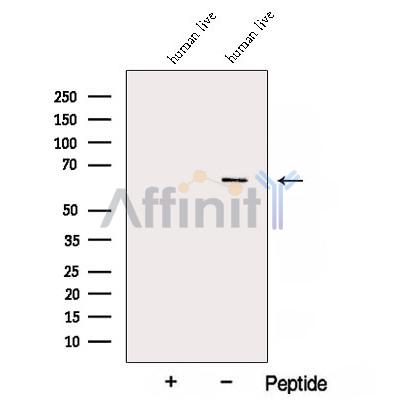ARHGAP15 Antibody - #DF12831
| Product: | ARHGAP15 Antibody |
| Catalog: | DF12831 |
| Description: | Rabbit polyclonal antibody to ARHGAP15 |
| Application: | WB IF/ICC |
| Reactivity: | Human, Mouse, Rat |
| Prediction: | Zebrafish, Bovine, Horse, Rabbit, Dog, Chicken |
| Mol.Wt.: | 65 kDa; 55kD(Calculated). |
| Uniprot: | Q53QZ3 |
| RRID: | AB_2845792 |
Related Downloads
Protocols
Product Info
*The optimal dilutions should be determined by the end user. For optimal experimental results, antibody reuse is not recommended.
*Tips:
WB: For western blot detection of denatured protein samples. IHC: For immunohistochemical detection of paraffin sections (IHC-p) or frozen sections (IHC-f) of tissue samples. IF/ICC: For immunofluorescence detection of cell samples. ELISA(peptide): For ELISA detection of antigenic peptide.
Cite Format: Affinity Biosciences Cat# DF12831, RRID:AB_2845792.
Fold/Unfold
ArhGAP15; BM046; RHG15_HUMAN; Rho GTPase activating protein 15; Rho GTPase-activating protein 15; Rho type GTPase activating protein 15; Rho-type GTPase-activating protein 15;
Immunogens
A synthesized peptide derived from human ARHGAP15, corresponding to a region within N-terminal amino acids.
- Q53QZ3 RHG15_HUMAN:
- Protein BLAST With
- NCBI/
- ExPASy/
- Uniprot
MQKSTNSDTSVETLNSTRQGTGAVQMRIKNANSHHDRLSQSKSMILTDVGKVTEPISRHRRNHSQHILKDVIPPLEQLMVEKEGYLQKAKIADGGKKLRKNWSTSWIVLSSRRIEFYKESKQQALSNMKTGHKPESVDLCGAHIEWAKEKSSRKNVFQITTVSGNEFLLQSDIDFIILDWFHAIKNAIDRLPKDSSCPSRNLELFKIQRSSSTELLSHYDSDIKEQKPEHRKSLMFRLHHSASDTSDKNRVKSRLKKFITRRPSLKTLQEKGLIKDQIFGSHLHKVCERENSTVPWFVKQCIEAVEKRGLDVDGIYRVSGNLATIQKLRFIVNQEEKLNLDDSQWEDIHVVTGALKMFFRELPEPLFPYSFFEQFVEAIKKQDNNTRIEAVKSLVQKLPPPNRDTMKVLFGHLTKIVAKASKNLMSTQSLGIVFGPTLLRAENETGNMAIHMVYQNQIAELMLSEYSKIFGSEED
Predictions
Score>80(red) has high confidence and is suggested to be used for WB detection. *The prediction model is mainly based on the alignment of immunogen sequences, the results are for reference only, not as the basis of quality assurance.
High(score>80) Medium(80>score>50) Low(score<50) No confidence
Research Backgrounds
GTPase activator for the Rho-type GTPases by converting them to an inactive GDP-bound state. Has activity toward RAC1. Overexpression results in an increase in actin stress fibers and cell contraction.
Cytoplasm. Membrane>Peripheral membrane protein.
Expressed in lung, liver and lymphoid cells.
The PH domain is required for localization to the membrane.
Restrictive clause
Affinity Biosciences tests all products strictly. Citations are provided as a resource for additional applications that have not been validated by Affinity Biosciences. Please choose the appropriate format for each application and consult Materials and Methods sections for additional details about the use of any product in these publications.
For Research Use Only.
Not for use in diagnostic or therapeutic procedures. Not for resale. Not for distribution without written consent. Affinity Biosciences will not be held responsible for patent infringement or other violations that may occur with the use of our products. Affinity Biosciences, Affinity Biosciences Logo and all other trademarks are the property of Affinity Biosciences LTD.


